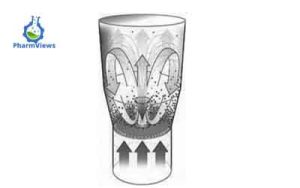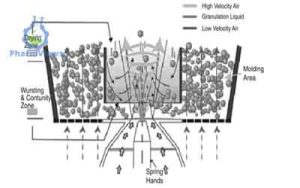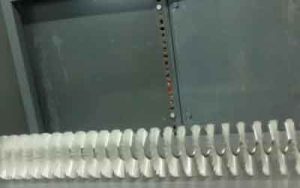Let us take a look at the spray coating machine and the essential processes involved in coating a pharmaceutical product.
Spray coating machine as the name implies is a pharmaceutical equipment used in coating various products in the pharmaceutical industry.
Bottom Spray Particle Coating/Agglomeration
The coating of the particles is carried out most frequently using Wurster column. The Wurster process is the most popular method for coating particles.
The Wurster-based coating process does not contain any fluid-bed regions in the traditional sense;
(A) Typical Wurster coater.
(B) Precision Coater
Four different regions within the spray coating machine can be identified: the upbed region, the expansion chamber, the downbed region, and the horizontal transport region.
The coating process consists of three phases:
- The start up phase
- The coating phase
- The drying and cooling phase.
During the coating phase, several processes take place simultaneously. They are as follows: atomization of the coating solution or suspension, transport of the atomized droplets of the coating solution to the substrate, and the drying of the film.

Bottom spray coating is also used for agglomeration as well as particle coating as it was developed originally.
By placement of nozzles tangentially, some manufacturers claim that separate modules to carry out agglomeration, coating, and drying will not be needed.
Of the modification of the basic Wurster Technique, a column within column (HS collar) was introduced by Glatt to minimize agglomeration during coating and enabling the higher spraying rate.
Further modification of the Wurster was introduced by GEA Pharma systems as a coating as well as bottom spray granulating technique with an introduction of Precision.
Fluid-bed process using organic solvent requires inert gas such as nitrogen to replace the air used for fluidization.
Basic process requirements for film coating
The fundamental requirements of a film-coating process are more or less independent of the actual type of equipment being used and include:
- Adequate means of atomizing the spray liquid for application to the tablet cores.
- Adequate mixing and agitation of the tablet bed. Spray coating relies on each core passing through the area of spraying (commonly called the spray zone) an equal number of times throughout the process.
- Sufficient energy input in the form of heated drying air to evaporate the solvent. This is particularly important when aqueous-based coatings are applied because they require more energy input as a result of the higher latent heat of vaporization of water.
- Good exhaust facilities to remove dust- and solvent-laden air
Film-coating formulations
Currently, the majority of film-coating processes involve the application of a coating liquid where a significant proportion of the main component (the solvent/vehicle) is removed by means of a drying process that is concurrent with the application of that coating liquid. Film-coating formulations typically comprise:
- Polymer
- Plasticizer
- Colourants
- Solvent/vehicle
There are certain types of coating process that differ from this common approach. For example, some processes involve the application of hot-melt coatings that congeal on cooling while others take advantage of recent developments in powder application technologies.

Film-coating polymers
The ideal characteristics of a film-coating polymer are discussed in the following sections. These proper[1]ties differ widely between the various polymers that might be considered for film-coating formulations.
Solubility Polymer
solubility is important for two reasons:
- It determines the behaviour of the coated product in the gastrointestinal tract (i.e. the rate at which the drug will be released, and whether there will be any delay in the onset of drug release).
- It determines the solubility of the coating in a chosen solvent system (a factor that can have great influence on the functional properties of the final coating)
Tablets coating
Tablets are often coated to protect the drug from the external environment, to mask bitter tastes, add mechanical strength, or to enhance ease of swallowing.
A coating can also be used for aesthetic or commercial purposes, improving product appearance and identity.
Other coating methods
See below;
Sugar – Coated Tablets Sugar
coating can be beneficial in masking taste, odors, and colors. It is useful in protecting against oxidation, and sugar coating was once very common due to its aesthetic results and cheapness of materials.
Use has declined in recent years due to the complexity of the process and skills required, but advances in technology have led to a resurgence in popularity.
Typical excipients used are sucrose (although this can be substituted with low – calorie alternatives), fillers, flavors, film formers, colorants, and surfactants. It is usually carried out in tumbling coating pans and comprises several stages.
Compression Coating and Layered Tablets
A coating can be applied by compression using specially designed tablet presses. The same process can be used to produce layered tablets which can comprise two or even three layers if complete separation of the ingredients is required.
This process is used when physical separation of ingredients is desired due to incompatibility or to produce a repeat – action product. The formulation can also be designed to provide an immediate and a slow – release component.
Film – Coated Tablets
Film coating, although most often applied to tablets, can also be used to coat other formulations including capsules.
Film coating imparts the same general characteristics as sugar coating but weight gain is significantly less (typically up to 5%), it is easier to automate, and it has capacity to include organic solvents if required. The main methods involved are modified conventional coating pans, side – vented pans, and fluid – bed coating.
Tablet Wrapping or Enrobing
Recent innovations in tablet coating include the use of gelatin and non – animal – derived coatings for tablets that require formulation of a pre – formed film that is then used to encapsulate the product.
Hard and soft gelatin capsules
Capsules are solid oral dosage forms in which the drug is enclosed within a hard or soft shell. The shell is normally made from gelatin and results in a simple, easy – to – swallow formulation with no requirement for a further coating step.
Tablet Polishing Machine
Once the colour coating layers have been applied and dried, the tablet surface tends to be smooth but somewhat dull in appearance.

To achieve the glossy finish that typifies sugar-coated products, a final stage involving the application of waxes is employed.
The tablet polishing machine is essential for the shinny looks of pharmaceutical products.
Automatic Tablet Printing Machine
The automatic tablet printing machine makes the printing work seamless and fast. It is a recommended equipment in the pharmaceutical industry.
It is common practice to identify all oral solid dosage forms with a manufacturer’s logo, product name, dosage strength or other appropriate code.
For sugar-coated products, such identification can be achieved only by means of a printing process, which is typically an offset gravure process using special edible inks.
However, alternative printing processes, such as ink-jet and pad-printing processes, have also gained acceptance.
Editor’s Picks
What is Tablet Coating Machine 2023
Bottle labeling machines in the pharmaceutical industry
Reference
Porter, S.C., 1999. A review of trends in film-coating technology. Am. Pharm. Rev. 2 (1), 32.
Porter, S.C., Felton, L.A., 2010. Techniques to assess film coatings and evaluate film-coated products. Drug Dev. Ind. Pharm. 36, 128–142.
Gelatin Capsule Working Group, Collaborative development of two – tier dissolution testing for gelatin capsules and gelatin – coated tablets using enzyme – containing media, Pharmacop. Forum , 24(5), Sept./Oct. 1998 .
